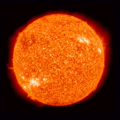File:SolarSystem OrdersOfMagnitude Sun-Jupiter-Earth-Moon.jpg

Size of this preview: Amachashazikazi ama-600 adlulayo nama-600 amile. Other resolutions: Amachashazikazi ama-240 adlulayo nama-240 amile | Amachashazikazi ama-480 adlulayo nama-480 amile | Amachashazikazi ama-768 adlulayo nama-768 amile | Amachashazikazi ama-1,024 adlulayo nama-1,024 amile | Amachashazikazi ama-2,048 adlulayo nama-2,048 amile | Amachashazikazi ama-4,010 adlulayo nama-4,010 amile.
Ifayela ewu ngqo (4,010 × 4,010 pixels, file size: 8.89 MB, MIME type: image/jpeg)
Umlando womqulu
Click on a date/time to view the file as it appeared at that time.
| Usuku/Isikhathi | Isithonjana | Dimensions | Umsebenzisi | Amazwana | |
|---|---|---|---|---|---|
| Njengamanje | 05:59, 12 uNhlaba 2012 |  | 4,010 × 4,010 (8.89 MB) | Tdadamemd |
Ukusetshenziswa komqulu
Awekho amakhasi asebenzisa lolu hlobo lomqulu.
Ukusetshenziswa komqulu jikelele
Amanye ama-wiki asebenzisa lefayela
- Ukusetshenziswa ku-az.wikipedia.org
- Ukusetshenziswa ku-ba.wikibooks.org
- Ukusetshenziswa ku-bn.wikibooks.org
- Ukusetshenziswa ku-de.wikipedia.org
- Ukusetshenziswa ku-en.wikipedia.org
- Ukusetshenziswa ku-en.wikibooks.org
- Ukusetshenziswa ku-es.wikipedia.org
- Ukusetshenziswa ku-et.wikipedia.org
- Ukusetshenziswa ku-eu.wikipedia.org
- Ukusetshenziswa ku-fa.wikipedia.org
- Ukusetshenziswa ku-fr.wikipedia.org
- Ukusetshenziswa ku-glk.wikipedia.org
- Ukusetshenziswa ku-hi.wikipedia.org
- Ukusetshenziswa ku-id.wikipedia.org
- Ukusetshenziswa ku-ja.wikipedia.org
- Ukusetshenziswa ku-ko.wikipedia.org
- Ukusetshenziswa ku-mk.wikipedia.org
- Ukusetshenziswa ku-pnb.wikipedia.org
- Ukusetshenziswa ku-pt.wikibooks.org
- Ukusetshenziswa ku-sk.wikipedia.org
- Ukusetshenziswa ku-sr.wikipedia.org
- Ukusetshenziswa ku-ur.wikipedia.org
- Ukusetshenziswa ku-vi.wikipedia.org
- Ukusetshenziswa ku-yi.wikipedia.org
- Ukusetshenziswa ku-zh.wikipedia.org


